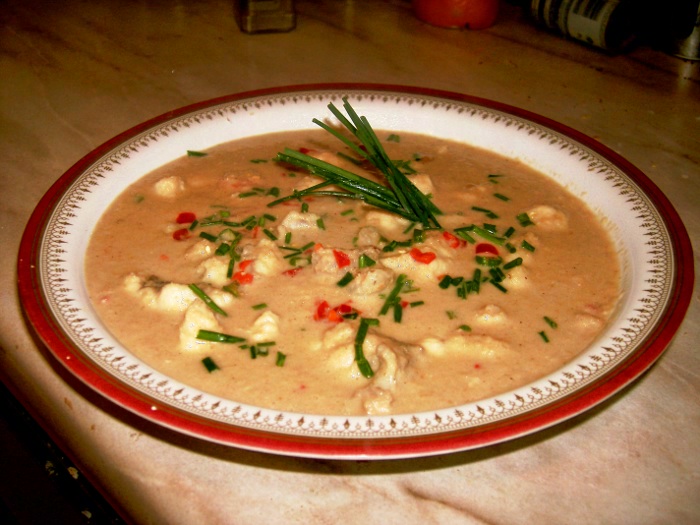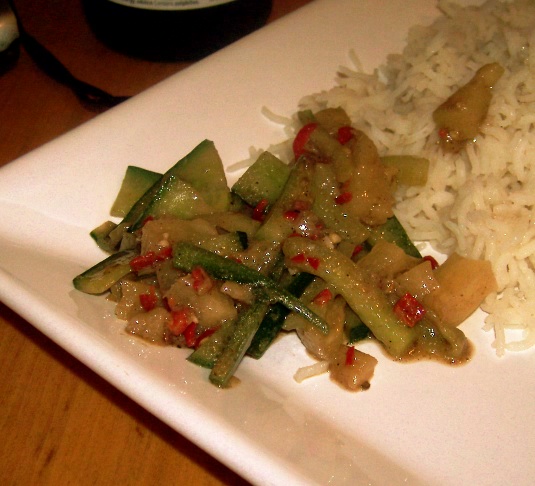
This all began with a curry. A curry that was neither heavily spiced nor very hot. A curry that didn’t come from India or Thailand and that contained neither huge amounts of cumin nor coriander nor curry leaves. This curry made me look at it and say out loud, “What the hell makes this a curry?”

Goon, who as usual wasn’t interested in probing the definitions of various food types, looked at me suspiciously and said “Well, you make curry at least once a fortnight. You should know!”
But in spite of being brought up on curry, I didn’t know. This bothered me. After a short spree of looking through various dictionary definions, the vast majority of which were about grooming horses, I found the origins of the word curry. It is the Dravidian (that’s classical Tamil) word for ‘vegetable in sauce’.
I think of all the curries I’ve made, possibly only a quarter involve vegetables in sauce. Have I been a terrible curry cook all this time?
I like to think not. I imagine what happened was that European settlers in India, who probably weren’t too keen on the whole veggie lifestyle, took the word they thought meant ‘generic vegetable stew’, turned it into the word that meant ‘generic stew with anything’ and expanded it to mean ‘generic anything with spice that has an origins in Asia’**.
It’s an exceptionally wide definition and as I looked through the list of curries I’ve made in my short cooking life, I can see that even they are remarkably varied. There’s everything from the hot and pungent vindaloo to the delicate monkfish curry I made last night.
This dish was so delicate that it needed an accompaniment with kick so I made a sambal to go with it. A sambal is another thing that is hard to define. In short it is a side dish made with chilli or a hot pepper. In Sri Lanka the most popular ones seemed to be seeni sambal, (sweet onions with chilli) or pol sambal which is a bright orange dish made with dessicated coconut and chilli. The sambal I opted for was of Malaysian origin (to match the fish dish) and was made of pineapple and thinly sliced cucumber in a dressing of lime, shrimp paste and pounded red chilli.

Malaysian Fish Curry with Sambal Nanas (for two generous portions)
- 400g monkfish fillet (or other firm white fish), cut into bite sized pieces
- 1 small onion, peeled and roughly chopped
- 2 inch piece of ginger, roughly chopped
- 3 fat garlic cloves, roughly chopped
- 2 red and two green chillies, deseeded and chopped
- A level tablespoon of flaked almonds, roughly crushed
- 2 lemongras staks, outer leaves removed, trimmed
- 3 heaped tablespooons dessicated coconut
- a pinch of turmeric
- 400g can coconut milk
- 100ml unherbed fish stock
- salt and pepper to taste
- chives or spring onion to garnish
- Plain boiled basmati rice to serve
For the Sambal
- 4 pineapple rings, chopped into small pieces.
- 1 quarter cucumber, sliced into short thin strips
- 1 teaspoon shrimp paste
- 20g dried shrimp
- 1 large red chilli, deseeded and finely chopped
- brown sugar to taste
To make the sambal, use a food processor to blitz the dried shrimp, chilli, lime juice and shrimp paste. to pound the chilli and dried shrimp. REmove the mixture from the processor and mix well with the pineapple and cucumber slices. Add sugar and more lime juice to taste. Set aside while you prepare the curry.
- Brush a medium saucepan with vegetable oil. Stir fry the dessicated coconut gently until it is a uniform golden brown. Scrape into a food processor and process to a smooth oily paste. I needed a touch of the coconut milk to help it alon.
- Scrape the processed coconut into a bowl and rinse out the food processer.
- Chop the lower halves of the lemon grass stalks roughly. Place the chopped lemongrass in the food processor with the onion, garlic, ginger, almond and three quarters of the chilli. Blitz to a smooth paste.
- Brown the monkfish pieces briefly, remove from the saucepan .
- Add the garlic paste to the pan and cook for afew minutes. Don’t let it brown. Then add the turmeric, coconut milk, remaining lemongrass and stock. Allow to reduce by half but don’t turn the heat up too high because coconut milk may curdle.
- Return the fish to the pan with the dessicated coconut paste. Stir well and allow the fish to cook through (this should take about 5 minutes over a low/medium heat).
- Taste, adjust seasoning and transfer to a serving bowl. Garnish with the remaining chillies and the chives. Serve with plain boiled rice.
*The corruption of words reminds me of ‘fish bisteck’. This is a Sri Lankan recipe my Dad used to try to impress me with when I was a teenager. The story goes that this was inspired by beef steak made by European settlers. Meat went off quickly in the hot weather, so beef steak was heavily spiced to disguise any gamey flavours. The locals picked up the idea and used the heavy spicing as a coating for fish (Buddhists aren’t big on eating beef). Beef steak –> bisteck–> fish bisteck
From the one or two encounters I had with fish bisteck I can promise that it was grim.
This all began with a curry. A curry that was neither heavily spiced nor very hot. A curry that didn’t come from India or Thailand and that contained neither huge amounts of cumin nor coriander nor curry leaves. This curry made me look at it and say out loud, “What the hell makes this a curry?”
Goon, who as usual wasn’t interested in probing the definitions of various food types, looked at me suspiciously and said “Well, you make curry at least once a fortnight. You should know!”
But in spite of being brought up on curry, I didn’t know. This bothered me. After a short spree of looking through various dictionary definions, the vast majority of which were about grooming horses, I found the origins of the word curry. It is the Dravidian (that’s classical Tamil) word for ‘vegetable in sauce’.
I think of all the curries I’ve made, possibly only a quarter involve vegetables in sauce. Have I been a terrible curry cook all this time?
I like to think not. I imagine what happened was that European settlers in India, who probably weren’t too keen on the whole veggie lifestyle, took the word they thought meant ‘generic vegetable stew’, turned it into the word that meant ‘generic stew with anything’ and expanded it to mean ‘generic anything with spice that has an origins in Asia’**.
It’s an exceptionally wide definition and as I looked through the list of curries I’ve made in my short cooking life, I can see that even they are remarkably varied. There’s everything from the hot and pungent vindaloo to the delicate monkfish curry I made last night.
This dish was so delicate that it needed an accompaniment with kick so I made a sambal to go with it. A sambal is another thing that is hard to define. In short it is a side dish made with chilli or a hot pepper. In Sri Lanka the most popular ones seemed to be seeni sambal, (sweet onions with chilli) or pol sambal which is a bright orange dish made with dessicated coconut and chilli. The sambal I opted for was of Malaysian origin (to match the fish dish) and was made of pineapple and thinly sliced cucumber in a dressing of lime, shrimp paste and pounded red chilli.
Malaysian Fish Curry with Sambal Nanas (for two generous portions)
- 400g monkfish fillet (or other firm white fish), cut into bite sized pieces
- 1 small onion, peeled and roughly chopped
- 2 inch piece of ginger, roughly chopped
- 3 fat garlic cloves, roughly chopped
- 2 red and two green chillies, deseeded and chopped
- A level tablespoon of flaked almonds, roughly crushed
- 2 lemongras staks, outer leaves removed, trimmed
- 3 heaped tablespooons dessicated coconut
- a pinch of turmeric
- 400g can coconut milk
- 100ml unherbed fish stock
- salt and pepper to taste
- chives or spring onion to garnish
- Plain boiled basmati rice to serve
For the Sambal
- 4 pineapple rings, chopped into small pieces.
- 1 quarter cucumber, sliced into short thin strips
- 1 teaspoon shrimp paste
- 20g dried shrimp
- 1 large red chilli, deseeded and finely chopped
- brown sugar to taste
To make the sambal, use a food processor to blitz the dried shrimp, chilli, lime juice and shrimp paste. to pound the chilli and dried shrimp. REmove the mixture from the processor and mix well with the pineapple and cucumber slices. Add sugar and more lime juice to taste. Set aside while you prepare the curry.
- Brush a medium saucepan with vegetable oil. Stir fry the dessicated coconut gently until it is a uniform golden brown. Scrape into a food processor and process to a smooth oily paste. I needed a touch of the coconut milk to help it alon.
- Scrape the processed coconut into a bowl and rinse out the food processer.
- Chop the lower halves of the lemon grass stalks roughly. Place the chopped lemongrass in the food processor with the onion, garlic, ginger, almond and three quarters of the chilli. Blitz to a smooth paste.
- Brown the monkfish pieces briefly, remove from the saucepan .
- Add the garlic paste to the pan and cook for afew minutes. Don’t let it brown. Then add the turmeric, coconut milk, remaining lemongrass and stock. Allow to reduce by half but don’t turn the heat up too high because coconut milk may curdle.
- Return the fish to the pan with the dessicated coconut paste. Stir well and allow the fish to cook through (this should take about 5 minutes over a low/medium heat).
- Taste, adjust seasoning and transfer to a serving bowl. Garnish with the remaining chillies and the chives. Serve with plain boiled rice.
*The corruption of words reminds me of ‘fish bisteck’. This is a Sri Lankan recipe my Dad used to try to impress me with when I was a teenager. The story goes that this was inspired by beef steak made by European settlers. Meat went off quickly in the hot weather, so beef steak was heavily spiced to disguise any gamey flavours. The locals picked up the idea and used the heavy spicing as a coating for fish (Buddhists aren’t big on eating beef). Beef steak –> bisteck–> fish bisteck
From the one or two encounters I had with fish bisteck I can promise that it was grim.



Well you have educated me! I had no idea about the origins of the word ‘curry’ - very interesting. I don’t curry fish very often so I shall have to remedy that. I do like the addition of the sambal - nice contrast.
Comment by Helen — February 22, 2009 @ 2:16 pm
Fish does seem to be somewhat underused in curry houses over here so not many home cooks think to use it either. Personally I love Goan fish curry and was quite taken by the texture of the monkfish in this curry. It was quite pricey though, so I’m saving it up for treat food!
Comment by ros — February 25, 2009 @ 11:23 am